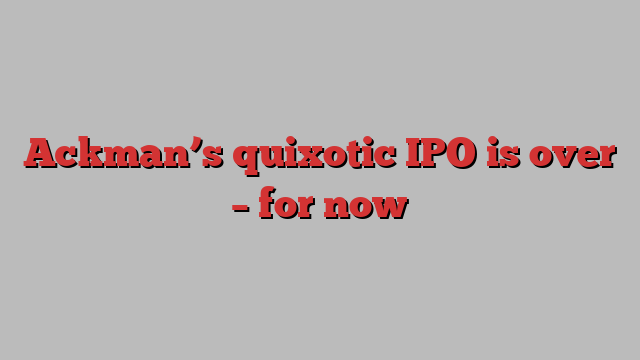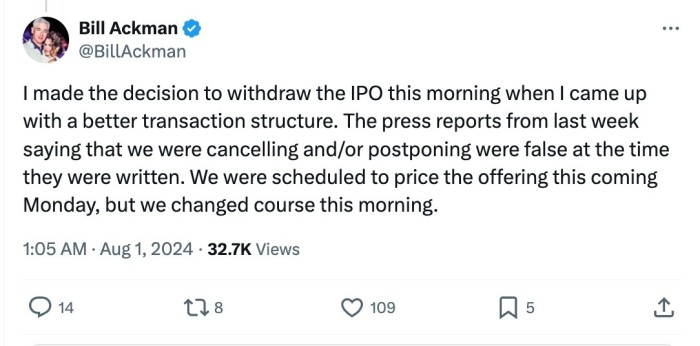
Unlock the Editor’s Digest for free
Roula Khalaf, Editor of the FT, selects her favourite stories in this weekly newsletter.
“To dream the impossible dream,” sings Don Quixote in the 1965 Broadway hit Man of La Mancha. “To fight the unbeatable foe . . . To run where the brave dare not go.”
Was Cervantes’ hero crazy or noble, delusional or courageous, foolish or high-minded? Maybe the man-formerly-known-Alonso Quijano was all of these, standing at the intersection of idealism and fantasy.
Few events in the capital markets have been as quixotic as Bill Ackman’s thwarted quest to list the Pershing Square USA (PSUS) fund on the New York Stock Exchange. Last night, Pershing Square announced it was withdrawing the IPO but vowed to relaunch at some point:
Over the last seven weeks, we have met with many institutions and family offices, and held numerous town halls for Pershing Square USA, Ltd. While we have received enormous investor interest in PSUS, one principal question has remained:
Would investors be better served waiting to invest in the aftermarket than in the IPO?
This question has inspired us to reevaluate PSUS’s structure to make the IPO investment decision a straightforward one. We will report back once we are ready to launch a revised transaction.
That will be a tall order.
Everything about this deal defied belief. First, it aimed to smash the all-time record for the largest-ever IPO with a $25bn target. Second, Pershing Square tweaked the structure to attract institutional investors, not just the usual retail buyers of closed-end investment fund IPOs. Third, Ackman aspired for the vehicle to trade at a premium to its net asset value (NAV), unlike almost every other similar one (including his own European-listed fund), by mobilising the collective power of his army of million-plus Twitter/X followers.
Just as Don Quixote longed to be remembered forever, Ackman’s IPO represented a bid for financial immortality. Pershing Square sought to raise an ungodly amount of permanent capital — capital that never has to be redeemed or returned — on which it would collect a 2 per cent fee stream for eternity.
The transaction, however, attracted a lot more attention than interest, even if it generated over $1bn of retail demand. The challenges were numerous. First, these permanent capital vehicles are always a tough sell to institutional investors. As FT Alphaville wrote on Monday, fund managers “are paid to manage money, not paid to pay Bill Ackman to manage money.” Fees-on-fees isn’t a great look for institutional investors.
Second, closed-end investment funds — especially consisting of publicly traded equities — almost always trade at a discount to NAV. There’s a huge amount of empirical analysis of this phenomenon dating back decades. Fighting the discount is the capital markets equivalent of tilting at windmills.
Third, as FTAV discussed on Monday, Pershing Square’s pattern of execution blunders made a challenging task much more difficult. The $25bn size was laughably unrealistic and exposed the firm to ridicule when the offering was downsized to $2bn.
Bill Ackman’s letter to key investors was also an indiscretion on multiple levels: it had to be filed with the SEC as a “free writing prospectus,” it disclosed three investors’ names (one of whom, Baupost, later declined to invest), and it revealed that institutional demand was weak. The appeal to his closest strategic partners to put in orders reeked of desperation.
The deal was already struggling to gain traction with fund managers, and after the Ackman letter was posted on the SEC website, the institutional book of demand must have collapsed, leaving mostly retail investors and Pershing Square itself, which had put in a $500mn anchor order.
It’s understandable why Ackman decided to pull the offering and go back to the drawing board. This must be deeply frustrating. Pershing Square had introduced robust governance, waived its first year of management fees, eliminated any performance fee, and pledged a $500mn investment. Ackman and his team presumably thought that they were offering a compelling proposition. But it wasn’t nearly enough to win over investors.
Cervantes’ Don Quixote suffers every imaginable humiliation and defeat. He is deceived, caged, beaten, robbed, and mocked, and yet he holds fast to his chivalric ideals. Bill Ackman has taken a beating with this failed float, but last night he vowed to pursue his quest — with some kind of “better transaction structure” that he’s apparently already come up with.

It will be interesting what structural innovations — short of actually paying investors out of Pershing Square’s own pocket to invest — will be proposed to convert the sceptics into believers.
Perhaps we won’t have to wait long for the next chapter in the Pershing Square USA saga, but don’t hold your breath.